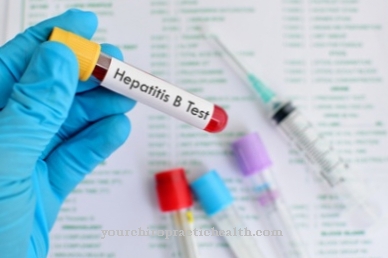At Cefotaxime it is an antibiotic. The active ingredient belongs to the third generation of cephalosporins.
What is cefotaxime?
Cefotaxime is a broad spectrum antibiotic that comes from group 3a of the cephalosporins. The active ingredient is used to treat bacterial infections. Just like other cephalosporins, cefotaxime is able to kill bacteria. The drug inhibits bacterial cell wall synthesis.
Cefotaxime was approved in the 1980s. In Germany and Austria, the prescription antibiotic is available as a monopreparation under the name Claforan®. Various generics are also offered.
Pharmacological effect
The way Cefotaxime works is based on the fact that the antibiotic prevents the bacteria from building their cell wall. For this purpose, it blocks the enzyme transpeptidase. As a result of this process, weak spots develop within the cell envelope of the germs. The weak points cause the cell wall of the bacteria to tear, which ultimately leads to the death of the pathogens.
In contrast to cephalosporins from group 1 such as cefazolin, cefotaxime unfolds its effect more efficiently against gram-negative bacteria. These include u. a. Enterobacteriaceae, meningococci and gonococci. A weak point of cefotaxime, however, is that it is less effective against pseudomonads than other cephalosporins from group 3a, which include ceftazidime, ceftriaxone and cefmenoxime.
Cefotaxime cannot work against certain germs that are already resistant to antibiotics. The types of bacteria against which the drug is effective against it include, for example, Salmonella, Enterobacter, Shigella, Escherichia coli, Pneumococci, Strepotococcus viridans, Proteus vulgaris, Neisseria gonorrhoeae (gonococci), Pasteurella, Klebsiella and anaerobes. In the gram-positive range, the effect of the agent against staphylococci is insufficient.
The half-life of cefotaxime in adult humans is around 60 minutes. In seniors or babies, it is often much longer. The antibiotic is mainly excreted through the kidneys.
Medical application & use
Cefotaxime is used against severe bacterial infections that can even be life-threatening. The areas of the body that are usually treated include the urinary tract such as the urethra, ureter, bladder and kidneys, the respiratory tract, the ear, nose and throat area and the skin.
Common indications for the use of cephalosporins are pneumonia, blood poisoning (sepsis), inflammation of the peritoneum (peritonitis), infections in the abdominal cavity, meningitis, inflammation of the inner lining of the heart (endocarditis), bone infections and infections of the soft tissues. If there are gaps in effectiveness, these are closed by administering additional antibiotics such as acylaminopenicillin or aminoglycoside.
Another treatment area for cefotaxime is neuroborreliosis, which is a manifestation of Lyme borreliosis. This disease is transmitted by ticks and caused by the bacterium Borrelia burgdorferi.
The administration of cefotaxime takes place via the intestine by means of an infusion.
Risks & side effects
Some patients may have undesirable side effects from taking cefotaxime. In most cases this results in a lack of blood platelets, the development of immature blood cells, allergic skin reactions such as itching, rash and hives, and drug fever. In addition, the concentration of urea and creatinine in the blood can increase.
Side effects can also sometimes be seen at the site of administration. These include pain at the injection site, hardening of the tissue or inflammatory reactions on the vein wall. Other occasional side effects are gastrointestinal problems such as diarrhea, abdominal pain, loss of appetite, nausea and vomiting, bloody inflammation of the large or small intestine, inflammation of the kidneys and additional infections from resistant bacteria.
If there is a hypersensitivity reaction to cefotaxime, which is accompanied by bronchial cramps, swelling of the face or a shock, therapy with the antibiotic must be stopped immediately.
If there is impaired kidney function or a tendency to allergies, a thorough risk-benefit assessment by the attending physician is required.
There is no experience with the administration of cefotaxime during pregnancy. No negative effects on the offspring were found in animal experiments. Nevertheless, strict control by the doctor is recommended for treatment during pregnancy.
During breastfeeding, the use of cefotaxime can disturb the intestinal flora of babies, as the antibiotic passes into breast milk, even if only in small amounts. Subsequently, the affected infants mostly suffer from diarrhea. In principle, however, therapy of newborns with the active ingredient is possible.
The simultaneous use of cefotaxime and other medicinal products occasionally causes interactions. The positive effect of the antibiotic is weakened when a combination with chloramphenicol, erythromycin, sulfonamides or tetracyclines takes place. Simultaneous administration of the gout medication probenecid hinders the excretion of cefotaxime from the body. Because of the longer-lasting concentration of the active ingredient in the blood, there is a risk of stronger side effects.












.jpg)



.jpg)










.jpg)
